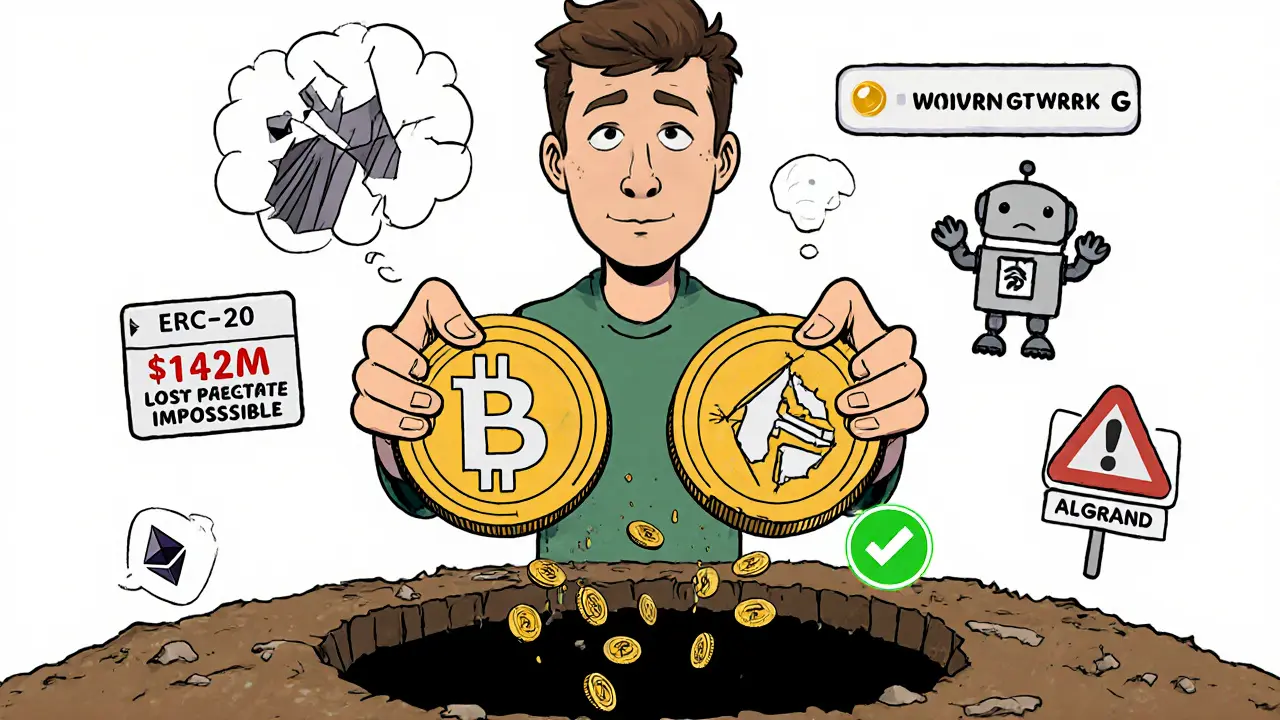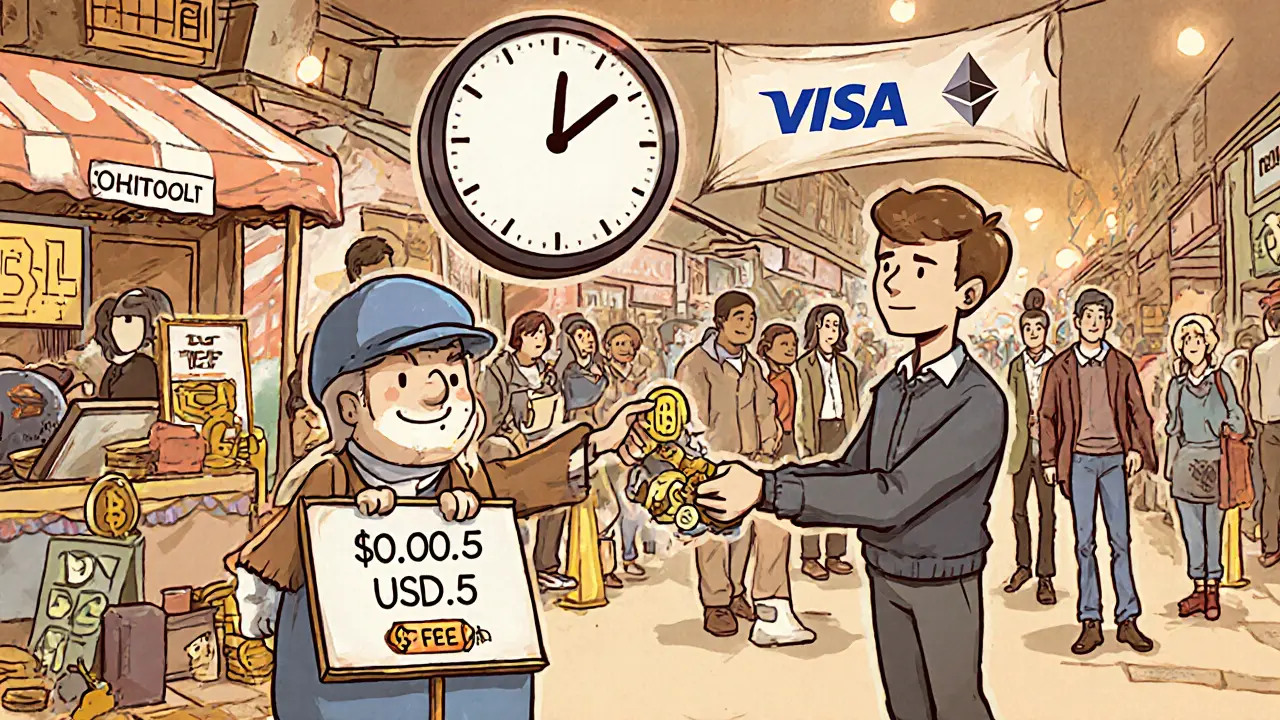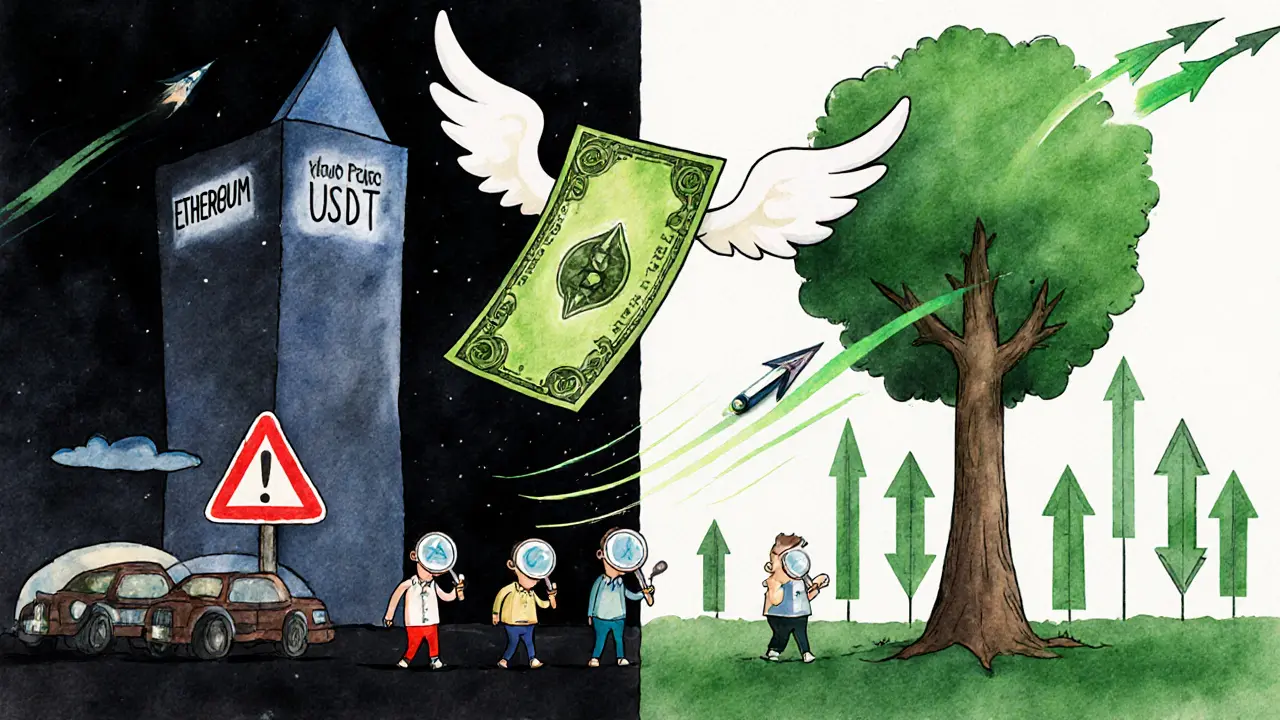Stablecoin Network Verification Tool
Verify Your Stablecoin Network
Send your stablecoins to the wrong blockchain? Your funds could be lost forever. This tool helps you confirm you're using the correct network before sending.
When you see USDT.a listed on a crypto exchange or wallet, it’s not a new coin-it’s the same Tether USD, just running on a different blockchain. Many beginners get confused thinking USDT.a is a separate stablecoin, but it’s not. It’s USDT, the world’s most traded crypto asset, adapted to work on the Algorand network. Understanding this difference isn’t just technical-it’s critical to avoid losing money.
What is USDT, really?
Tether USD (USDT) is a stablecoin, meaning its value is locked to the U.S. dollar. One USDT is always meant to be worth exactly $1. It was launched in 2014 and quickly became the backbone of crypto trading. Why? Because when Bitcoin or Ethereum crashes, traders don’t want to cash out into bank accounts-they want to hold something stable, but still on the blockchain. USDT lets them do that. It’s issued by Tether Limited, a company based in the British Virgin Islands. Unlike Bitcoin, which is decentralized, Tether is centralized. That means the company controls the supply, holds the reserves, and can freeze or block transactions. That’s a trade-off: you get speed, low fees, and massive liquidity-but you’re trusting a single company to back every USDT with real dollars. As of October 2025, there are over 183 billion USDT tokens in circulation. That’s more than the entire market cap of most cryptocurrencies. It’s used on exchanges like Binance, Bybit, and Kraken for trading pairs, on DeFi platforms for lending, and even in cross-border payments in countries like Nigeria and Venezuela where traditional banking is slow or expensive.Why does USDT have a .a at the end?
USDT doesn’t live on just one blockchain. It’s been copied-or “bridged”-onto six different networks: Bitcoin (via Omni), Ethereum, Tron, EOS, OMG, and Algorand. Each version has its own technical identity. That’s where the suffix comes in:- USDT (on Ethereum) = ERC-20 token
- USDT (on Tron) = TRC-20 token
- USDT.a (on Algorand) = ASA token
How is USDT.a different from regular USDT?
Here’s the key: USDT.a and USDT are identical in value, but not in how they work. | Feature | USDT (Ethereum) | USDT.a (Algorand) | |--------|------------------|-------------------| | Network | Ethereum | Algorand | | Token Standard | ERC-20 | ASA (Algorand Standard Asset) | | Transaction Speed | 15-30 seconds | 4.5 seconds | | Average Fee | $0.85-$2.50 | Under $0.001 | | Contract Address | 0xdac17f958d2ee523a2206206994597c13d831ec7 | Asset ID: 312769 | | Reserve Backing | Same (1:1 USD) | Same (1:1 USD) | | Supported Exchanges | All major exchanges | Mostly Binance, KuCoin, OKX, and Algorand-native platforms | The biggest difference? They’re not interchangeable. If you send USDT (ERC-20) to a USDT.a (Algorand) address, your funds are gone forever. There’s no way to recover them. Chainalysis recorded over $142 million lost this way in 2024 alone.
Why do people use USDT.a?
Most traders use USDT.a for one reason: cost and speed. If you’re trading altcoins on a platform that supports Algorand, using USDT.a saves you money and time. For example:- You buy $1,000 worth of SOL on Binance using USDT.a. Transfer to your wallet: 4 seconds, $0.0005 fee.
- You do the same with USDT (Ethereum): 22 seconds, $1.80 fee.
What are the risks of USDT.a?
The biggest risk isn’t the Algorand network-it’s Tether itself. Tether’s reserves aren’t 100% cash. According to their Q2 2025 report, only 82.7% is in cash and equivalents. The rest is in corporate bonds, secured loans, and other assets. That’s fine if markets are calm. But if a bank fails or a loan defaults, the $1 peg could wobble. It’s happened before: in March 2020, USDT dropped to $0.93 during the pandemic crash. There’s also regulatory risk. The U.S. SEC has been pushing for stricter rules on stablecoins. Tether was fined $18.5 million in 2021 for misleading claims about its reserves. If new laws force Tether to hold 100% cash reserves, it could hurt their profit margins-and make USDT less attractive compared to Circle’s USDC, which already does. Finally, there’s user error. If you’re new to crypto and don’t know the difference between USDT and USDT.a, you could send funds to the wrong network. That’s not a hack. That’s a mistake-and it’s irreversible.How to safely use USDT.a
If you want to use USDT.a, follow these steps:- Check your wallet. Does it support Algorand? Trust Wallet, MetaMask (with Algorand extension), and Algorand’s official wallet do. If it doesn’t, you can’t receive USDT.a.
- Confirm the network. When withdrawing from an exchange, always select “Algorand” or “USDT.a.” Never pick “Ethereum” or “Tron.”
- Verify the address. Algorand addresses start with “G.” If your deposit address starts with “0x,” it’s Ethereum-and wrong for USDT.a.
- Test with a small amount. Send $1 first. Wait for confirmation. Only then send more.
- Use a blockchain explorer. Go to AlgoExplorer and paste your transaction ID. You’ll see if it settled on Algorand.

Is USDT.a the future of stablecoins?
Not alone-but it’s part of a bigger trend. The crypto world is moving toward multi-chain stability. No single blockchain can handle all demand. Algorand, Solana, and Polygon are gaining ground because they’re faster and cheaper than Ethereum. Tether’s decision to support USDT.a shows they’re not betting on one chain. They’re hedging. If Ethereum becomes too expensive or slow, USDT.a keeps them relevant. Institutional investors are watching. Fidelity’s Digital Assets Report shows that 27.4% of USDT volume now comes from institutions. But U.S.-based firms still prefer USDC because it’s audited monthly by Grant Thornton. USDT.a doesn’t change that-it just gives traders more options.What’s next for USDT.a?
Tether is expanding its Algorand integration. In September 2025, they partnered with Visa to let businesses settle payments in USDT.a. The first $2.4 billion in transactions cleared in 30 days. That’s a sign this isn’t just for traders-it’s becoming a payment rail. Tether also plans to integrate with central bank digital currencies (CBDCs) by early 2026. If Hong Kong’s e-HKD can connect with USDT.a, it could open a direct path for cross-border trade between Asia and the U.S.-without banks. For now, USDT.a is the quiet workhorse of high-speed crypto trading. It’s not flashy. It doesn’t make headlines. But if you’re serious about trading altcoins, it’s one of the most useful tools you can use-if you know how to use it right.Is USDT.a safe?
It’s as safe as the network it runs on and the company behind it. Algorand is secure, decentralized, and energy-efficient. Tether is not. But if you’re using USDT.a for trading and not long-term holding, the risk is manageable. Use it for moving value quickly between exchanges. Don’t use it as a savings account. And never, ever send it to the wrong network.Is USDT.a the same as USDT?
Yes, USDT.a is the same Tether USD stablecoin, just issued on the Algorand blockchain instead of Ethereum or Tron. The value is still $1 per token, and it’s backed by the same reserves. The only difference is the blockchain it runs on, which affects speed, fees, and how you send it.
Can I convert USDT to USDT.a?
You can’t convert them directly in your wallet. You need to withdraw USDT from one network (like Ethereum) and deposit it into a wallet or exchange that supports Algorand. Then, you’ll receive USDT.a. Most major exchanges like Binance and KuCoin offer this as a withdrawal option-just select the correct network.
Why is USDT.a cheaper than USDT on Ethereum?
Algorand uses a different consensus mechanism called Pure Proof of Stake, which is faster and uses far less energy than Ethereum’s old system. Transactions settle in under 5 seconds with fees under $0.001. Ethereum, even after its upgrade, still has higher demand and gas fees, especially during busy times.
What happens if I send USDT.a to a USDT (Ethereum) address?
Your funds will be lost permanently. The Algorand network doesn’t recognize Ethereum addresses, and vice versa. There is no recovery process. Always double-check the network before sending. Use a blockchain explorer like AlgoExplorer to verify the transaction destination.
Is USDT.a better than USDC on Algorand?
USDT.a has far more liquidity and is accepted on more exchanges than USDC on Algorand. But USDC is fully backed by cash and audited monthly, making it more trusted for institutional use. If you’re trading, USDT.a is better. If you’re holding long-term or need regulatory compliance, USDC is safer.

USDT.a is such a quiet hero in the crypto space. Nobody talks about it, but if you're doing high-frequency trades on Algorand, it's the only way to go. Fees under a penny? Speed under five seconds? That's not just convenient-it's revolutionary compared to Ethereum's gas tax hell. I've lost count of how many times I've saved $50+ in a week just by switching.
And yeah, the risk isn't the chain-it's trusting Tether's reserve disclosures. But for short-term trading? It's a no-brainer. Just don't ever send it to a 0x address. I've seen people lose six figures that way.
USDT a is faster and cheaper than USDT on ethereum period end of story
So let me get this straight… we’re all fine with a company based in the BVI holding $183B in ‘reserves’ that are 82% bonds and ‘secured loans’… but we’re terrified of sending crypto to the wrong network? 🤔
Also typo: ‘saves you money and time’ - yeah, unless you’re the one paying $1.80 in gas while Tether makes $20M in interest on your ‘cash’.
i just learned about usdt.a last week and wow i had no idea it was the same as usdt but on algorand
so if i send usdt from binance to my trust wallet and pick algorand… it becomes usdt.a? and if i pick erc20 it stays usdt? i think i get it now
also why does algorand even have a .a at the end? why not just call it usdt? seems confusing
Anyone else notice how USDT.a is basically the underdog that won? Ethereum used to be the king of stablecoins, but now Algorand’s got the speed, the fees, and the reliability. Blockworks tracked 147 flawless transactions? That’s insane. Ethereum’s still stuck with 11 failures in the same batch.
And the fact that Visa is now settling $2.4B in USDT.a? That’s not a niche thing anymore. This is infrastructure. We’re watching history.
It’s funny how we treat USDT.a like it’s some magical innovation when it’s just a bridge. The real question isn’t which chain it runs on-it’s whether we should be using centralized stablecoins at all.
If the goal is decentralization, why are we putting our trust in a single company’s balance sheet? USDC might be slower, but at least it’s audited. USDT.a is just USDT with a new coat of paint.
Maybe the future isn’t multi-chain stablecoins… but multi-chain *decentralized* money. Just saying.
Dont send usdt.a to eth address you lose everything
NEWBIE TIP 💡: Always, ALWAYS check the network before you send! I lost $200 once because I clicked ‘Ethereum’ instead of ‘Algorand’ 😭
Algorand addresses start with G-like G123abc456xyz. Ethereum starts with 0x. If you see 0x, STOP. That’s not for USDT.a!
Test with $1 first. I swear by it. And use AlgoExplorer to check your tx. It’s free and super easy. You’re not a hacker-you’re just trying not to lose your money. 😅
So let me get this straight… we’re glorifying a centralized stablecoin because it’s cheap? That’s not innovation, that’s capitulation.
Meanwhile, the same people who scream ‘decentralize everything’ are happily using Tether because ‘it’s faster.’
What are we even doing here? We built blockchain to escape banks… and now we’re begging Tether Limited to be our new bank with lower fees?
And don’t even get me started on the ‘USDT.a is the future’ narrative. The future is permissionless. Not ‘permissioned with better UX.’
USDT.a is the only way to trade if you care about money. Ethereum fees are a scam. Algorand is clean and fast. USDC on Algorand? Barely used. USDT.a is everywhere. If you’re not using it you’re leaving money on the table. Stop overthinking and just use it.
Just wanted to say thanks for this guide. I’ve been trading for a year and didn’t even know the difference between USDT and USDT.a until now.
My first USDT.a transfer was $500-got it in 3.8 seconds with $0.0003 fee. I almost cried. I’ve been paying $2 every time I moved funds on Ethereum. That’s $60 a month gone.
Also, I tested it with $1 like the post said. Best $1 I ever spent.
USDT.a = instant trades 💸🚀 No more waiting 20 seconds for a transfer. Algorand is the real MVP of stablecoins. Tether? Still sketchy. But the tech? Fire.
While the technical distinctions are accurate, I must emphasize the ethical responsibility inherent in using centralized stablecoins. The reliance on Tether Limited-whose reserve transparency remains incomplete and legally contentious-represents a systemic vulnerability in the broader crypto ecosystem.
Furthermore, the normalization of network-specific token variants (e.g., USDT.a) introduces unnecessary complexity for newcomers, potentially increasing the risk of irreversible loss. We must prioritize education, not convenience.
Until stablecoins are fully backed, independently audited, and governed transparently, they remain instruments of financial fragility-not innovation.
Consider: if your savings depend on a company’s balance sheet, are you truly owning crypto-or just renting it?